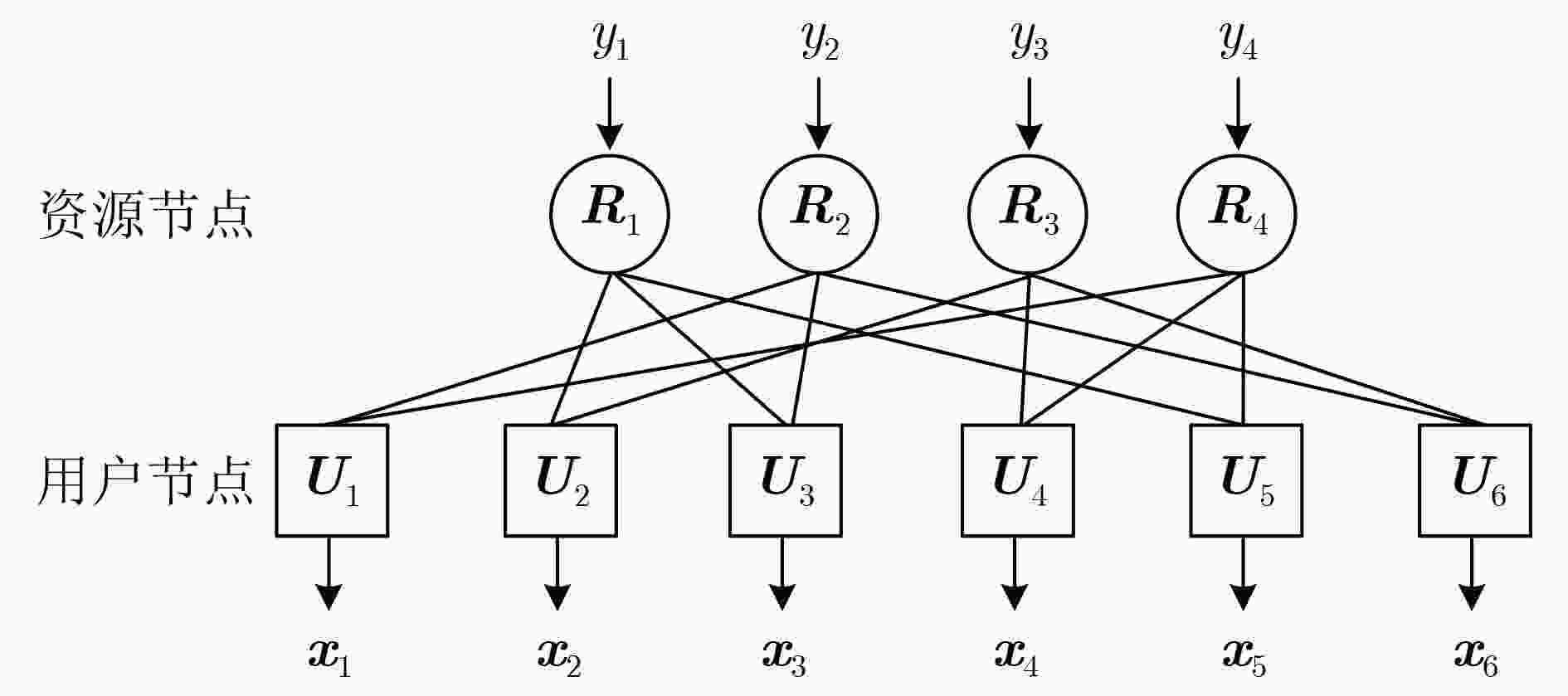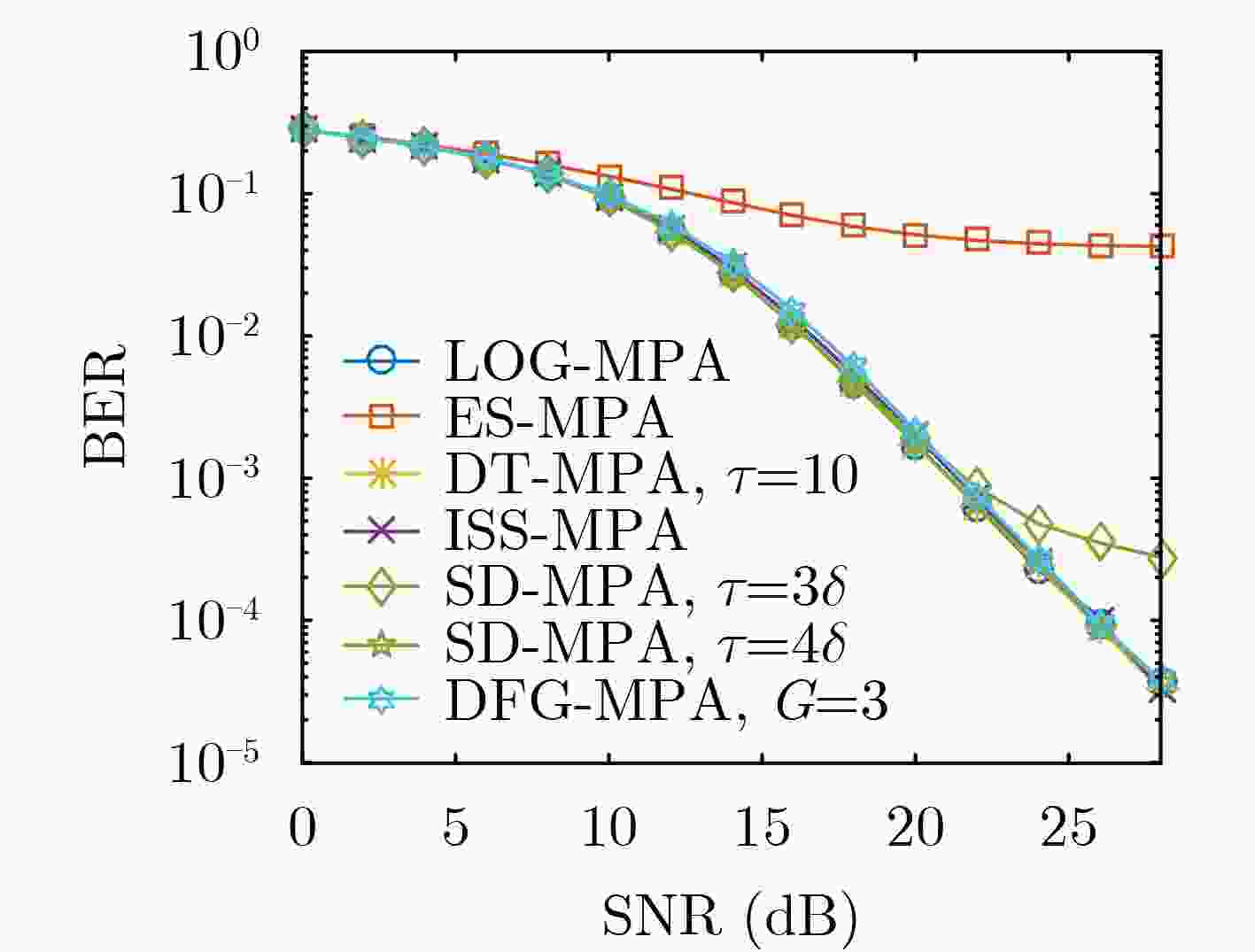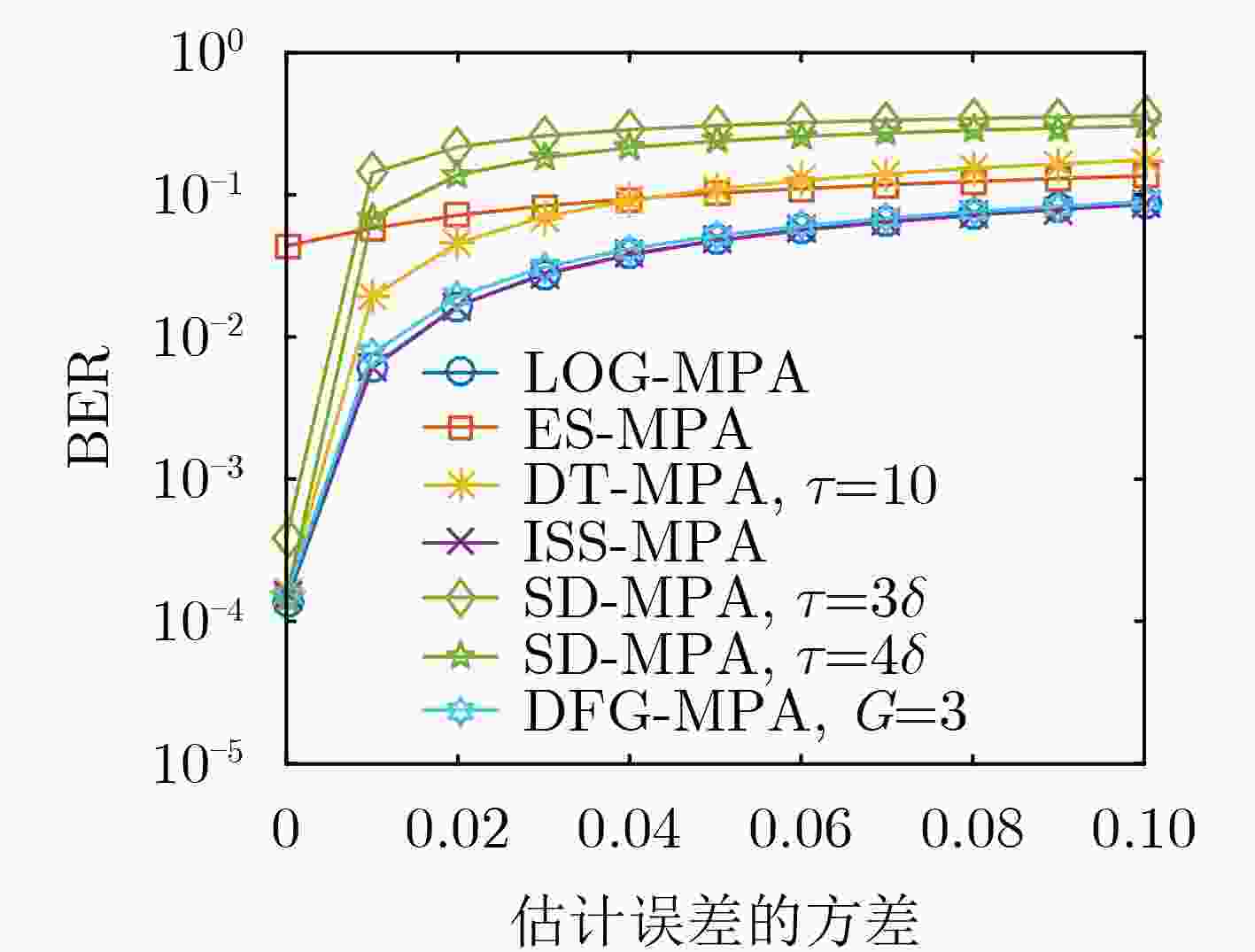Survey of Multi-user Detection Algorithms for Sparse Code Multiple Access System
-
摘要: 稀疏码多址接入(SCMA)是一种非正交多址接入技术,具备高频谱效率和大连接特性。多用户检测是SCMA系统的关键问题,而如何降低检测算法的复杂度成为多址接入领域的研究热点。该文从影响算法复杂度的不同因素入手,分类综述了现有多用户检测算法并对几种典型算法进行了原理剖析和性能对比。同时,指出了SCMA多用户检测算法的改进思路。最后总结并探讨了SCMA检测算法未来的发展趋势和面临的挑战。Abstract: Sparse Code Multiple Access (SCMA) is a non-orthogonal multiple access scheme with high spectrum efficiency and massive connectivity. Multi-user detection is a key issue of SCMA system and how to reduce the complexity of detection algorithms has become a research hotspot in the field of multiple access. This paper reviews the existing multi-user detection algorithms from different factors that affect the complexity of the algorithms. Furthermore, the principle and performance of several typical multi-user detection algorithms are introduced and compared. In addition, the improved ideas of multi-user detection algorithms for SCMA system are pointed out in this paper. Finally, the future development trend and challenges of SCMA detection algorithms are summarized and discussed.
-
表 1 LOG-MPA算法与各类算法加法复杂度对比分析
算法 加法 LOG-MPA $TK{d_r}{M^{{d_r}}}(2{d_r} + 1) + TK{d_r}(3{M^{{d_r}}} - M) + TJ{d_v}M({d_v} - 2) + JM({d_v} - 1)$ DT-MPA $\begin{gathered} K{d_r}{M^{ {d_r} } }(2{d_r} + 1) + K{d_r}(3{M^{ {d_r} } } - M) + J{d_v}M({d_v} - 2) + JM({d_v} - 1) + J(3M - 3) \\ + \sum\limits_{t = 1}^{T - 1} {\sum\limits_{k = 1}^K { {d_r}\prod\limits_{i = 1}^{ {d_r} } { {m_c}[t,{\xi _k}(i)](2{d_r} + 1) + } \sum\limits_{t = 1}^{T - 1} {\sum\limits_{k = 1}^K {(3{d_r}{m_c}[t,{\xi _k}(i)] - \sum\limits_{i = 1}^{ {d_r} } { {m_c}[t,{\xi _k}(i)]} )} } } } \\ + \sum\limits_{t = 1}^{T - 1} {\sum\limits_{j = 1}^J { {d_v}{m_c}[t,j]} } ({d_v} - 2) + \sum\limits_{t = 1}^{T - 1} {\sum\limits_{j = 1}^J { {m_c}[t,j]} } ({d_v} - 1) + \sum\limits_{t = 1}^{T - 1} {\sum\limits_{j = 1}^J {(3{m_c}[t,j]} } - 3) \\ \end{gathered}$ ISS-MPA ${T'}K{d_r}{M^{{d_r}}}(2{d_r} + 1) + {T'}K{d_r}(3{M^{{d_r}}} - M) + {T'}J{d_v}M({d_v} - 2) + JM({d_v} - 1)$ ES-MPA $TK{d_r}(M + 3{d_r} - 2{d_s} - 5) + TK{d_r}{M^{{d_s} + 1}}(2{d_s} + 5) + TJ{d_v}M({d_v} - 2) + JM({d_v} - 1)$ SD-MPA $T{d_r}\displaystyle\sum\limits_{k = 1}^K {|\phi (k)} |(2{d_r} + 1) + T{d_r}\left(3\displaystyle\sum\limits_{k = 1}^K {|\phi (k)} | - KM\right) + TJ{d_v}M({d_v} - 2) + JM({d_v} - 1)$ DFG-MPA $\begin{gathered} \sum\limits_{t = 1}^T {|{{\boldsymbol{B}}_s}(t)} |{M^{{d_r}}}(2{d_r} + 1) + \sum\limits_{t = 1}^T {|{{\boldsymbol{B}}_s}(t)|} (3{M^{{d_r}}} - M) + \sum\limits_{t = 1}^T {|{{\boldsymbol{B}}_s}(t)} |(2M - 1) - T \\ + TJ{d_v}M({d_v} - 2) + JM({d_v} - 1) \\ \end{gathered} $ 表 2 LOG-MPA算法与各类算法乘法复杂度对比分析
算法 乘法 LOG-MPA $ TK{d}_{r}{M}^{{d}_{r}}({d}_{r}+2)+TK{d}_{r}({M}^{{d}_{r}}+M)$ DT-MPA $\begin{array}{l}K{d}_{r}{M}^{ {d}_{r} }({d}_{r}+2)+K{d}_{r}({M}^{ {d}_{r} }+M)+{\displaystyle\sum\limits_{t=1}^{T-1}{\displaystyle\sum\limits_{k=1}^{K}{d}_{r}{\displaystyle \prod _{i=1}^{ {d}_{r} }{m}_{c}[t,{\xi }_{k}(i)]({d}_{r}+2})} }\\ +{\displaystyle\sum\limits_{t=1}^{T-1}{\displaystyle\sum\limits_{k=1}^{K}\left({d}_{r}{\displaystyle \prod _{i=1}^{ {d}_{r} }{m}_{c}[t,{\xi }_{k}(i)]+{\displaystyle\sum\limits_{i=1}^{ {d}_{r} }{m}_{c}[t,{\xi }_{k}(i)]} }\right)} }\end{array}$ ISS-MPA $ {T}'K{d}_{r}{M}^{{d}_{r}}({d}_{r}+2)+{T}'K{d}_{r}({M}^{{d}_{r}}+M)$ ES-MPA $TK{d_r}(4M + 2{d_r} - 2{d_s}) + TK{d_r}{M^{{d_s} + 1}}({d_s} + 3) + TK{d_r}({M^{{d_s} + 1}} + M)$ SD-MPA $T{d}_{r}{\displaystyle\sum\limits_{k=1}^{K}|\varphi (k)}|({d}_{r}+2)+T{d}_{r}\left({\displaystyle\sum\limits_{k=1}^{K}|\varphi (k)}|+KM\right)$ DFG-MPA $ {\displaystyle\sum\limits_{t=1}^{T}|{\boldsymbol{B}}_{s}(t)}|{M}^{{d}_{r}}({d}_{r}+2)+{\displaystyle\sum\limits_{t=1}^{T}|{\boldsymbol{B}}_{s}(t)}|({M}^{{d}_{r}}+M)+{\displaystyle\sum\limits_{t=1}^{T}|{\boldsymbol{B}}_{s}(t)}|(2M+1)$ 注:${T'}$为ISS-MPA的迭代次数;${m_c}[t,{\xi _k}(i)]$为第$t$次迭代中,与资源$k$连接的第$i$用户的码本大小;${m_c}[t,j]$为第$t$次迭代中,第$j$个用户的码本大小;$\phi (k)$为资源节点$k$上给定半径范围内的叠加星座点;${{\boldsymbol{B}}_s}(t)$第$t$次迭代时的实线分支集。 表 3 仿真参数
参数 值 信道条件 瑞利衰落信道 蒙特卡罗次数 107 $J$ 6 $K$ 4 ${d_r}$ 3 ${d_v}$ 2 $\lambda $ 150% $G$ 3 $\tau $ 10 $r$ 3$\delta $或4$\delta $ 注:$\delta $为噪声的标准差。 -
[1] ZHANG Zhengquan, XIAO Yue, MA Zheng, et al. 6G wireless networks: Vision, requirements, architecture, and key technologies[J]. IEEE Vehicular Technology Magazine, 2019, 14(3): 28–41. doi: 10.1109/mvt.2019.2921208 [2] BARIAH L, MOHJAZI L, MUHAIDAT S, et al. A prospective look: Key enabling technologies, applications and open research topics in 6G networks[J]. IEEE Access, 2020, 8: 174792–174820. doi: 10.1109/ACCESS.2020.3019590 [3] SAAD W, BENNIS M, and CHEN Mingzhe. A vision of 6G wireless systems: Applications, trends, technologies, and open research problems[J]. IEEE Network, 2020, 34(3): 134–142. doi: 10.1109/MNET.001.1900287 [4] DING Zhiguo, LEI Xianfu, KARAGIANNIDIS G K, et al. A survey on non-orthogonal multiple access for 5G networks: Research challenges and future trends[J]. IEEE Journal on Selected Areas in Communications, 2017, 35(10): 2181–2195. doi: 10.1109/JSAC.2017.2725519 [5] DOGRA A, JHA R K, and JAIN S. A survey on beyond 5G network with the advent of 6G: Architecture and emerging technologies[J]. IEEE Access, 2020, 9: 67512–67547. doi: 10.1109/ACCESS.2020.3031234 [6] HOSHYAR R, RAZAVI R, and AL-IMARI M. LDS-OFDM an efficient multiple access technique[C]. 2010 IEEE 71st Vehicular Technology Conference, Taipei, China, 2010: 1–5. doi: 10.1109/VETECS.2010.5493941. [7] NIKOPOUR H and BALIGH H. Sparse code multiple access[C]. The 24th IEEE Annual International Symposium on Personal, Indoor, and Mobile Radio Communications, London, UK, 2013: 332–336. doi: 10.1109/PIMRC.2013.6666156. [8] WU Yiqun, ZHANG Shunqing, and CHEN Yan. Iterative multiuser receiver in sparse code multiple access systems[C]. 2015 IEEE International Conference on Communications, London, UK, 2015: 2918–2923. doi: 10.1109/ICC.2015.7248770. [9] HOSHYAR R, WATHAN F P, and TAFAZOLLI R. Novel low-density signature for synchronous CDMA systems over AWGN channel[J]. IEEE Transactions on Signal Processing, 2008, 56(4): 1616–1626. doi: 10.1109/TSP.2007.909320 [10] TAHERZADEH M, NIKOPOUR H, BAYESTEH A, et al. SCMA codebook design[C]. The 80th IEEE Vehicular Technology Conference, Vancouver, Canada, 2014: 1–5. doi: 10.1109/VTCFall.2014.6966170. [11] CAI Donghong, FAN Pingzhi, LEI Xianfu, et al. Multi-dimensional SCMA codebook design based on constellation rotation and interleaving[C]. The 83rd IEEE Vehicular Technology Conference, Nanjing, China, 2016: 1–5. doi: 10.1109/VTCSpring.2016.7504356. [12] MHEICH Z, WEN Lei, XIAO Pei, et al. Design of SCMA codebooks based on golden angle modulation[J]. IEEE Transactions on Vehicular Technology, 2019, 68(2): 1501–1509. doi: 10.1109/tvt.2018.2886953 [13] CHEN Yenming and CHEN Jianwei. On the design of near-optimal sparse code multiple access codebooks[J]. IEEE Transactions on Communications, 2020, 68(5): 2950–2962. doi: 10.1109/tcomm.2020.2974213 [14] ABEBE A T and KANG C G. Multiple codebook-based non-orthogonal multiple access[J]. IEEE Wireless Communications Letters, 2020, 9(5): 683–687. doi: 10.1109/lwc.2020.2965939 [15] LU Lei, CHEN Yan, GUO Wenting, et al. Prototype for 5G new air interface technology SCMA and performance evaluation[J]. China Communications, 2015, 12(S1): 38–48. doi: 10.1109/CC.2015.7386169 [16] NIKOPOUR H, YI E, BAYESTEH A, et al. SCMA for downlink multiple access of 5G wireless networks[C]. 2014 IEEE Global Communications Conference, Austin, USA, 2014: 3940–3945. doi: 10.1109/GLOCOM.2014.7037423. [17] AU K, ZHANG Liqing, NIKOPOUR H, et al. Uplink contention based SCMA for 5G radio access[C]. 2014 IEEE Globecom Workshops, Austin, USA, 2014: 900–905. doi: 10.1109/GLOCOMW.2014.7063547. [18] 文磊. 多进制LDPC码在码分多址系统中的应用研究[D]. [博士论文], 国防科学技术大学, 2016.WEN Lei. Research of application of nonbinary LDPC codes in code division multiple access systems[D]. [Ph. D. dissertation], National University of Defense Technology, 2016. [19] VERDU S. Minimum probability of error for asynchronous multiple access communication systems[C]. MILCOM 1983-IEEE Military Communications Conference, Washington, USA, 1983: 213–219. doi: 10.1109/MILCOM.1983.4794684. [20] VARANASI M K and AAZHANG B. Near-optimum detection in synchronous code-division multiple-access systems[J]. IEEE Transactions on Communications, 1991, 39(5): 725–736. doi: 10.1109/26.87163 [21] XIE Zhenhua, SHORT R T, and RUSHFORTH C K. A family of suboptimum detectors for coherent multiuser communications[J]. IEEE Journal on Selected Areas in Communications, 1990, 8(4): 683–690. doi: 10.1109/49.54464 [22] PATEL P and HOLTZMAN J. Analysis of a simple successive interference cancellation scheme in a DS/CDMA system[J]. IEEE Journal on Selected Areas in Communications, 1994, 12(5): 796–807. doi: 10.1109/49.298053 [23] KSCHISCHANG F R, FREY B J, and LOELIGER H A. Factor graphs and the sum-product algorithm[J]. IEEE Transactions on Information Theory, 2001, 47(2): 498–519. doi: 10.1109/18.910572 [24] XIAO Kexin, XIAO Baicen, ZHANG Shutian, et al. Simplified multiuser detection for SCMA with sum-product algorithm[C]. 2015 International Conference on Wireless Communications & Signal Processing, Nanjing, China, 2015: 1–5. doi: 10.1109/WCSP.2015.7341328. [25] LAI Ke, WEN Lei, LEI Jing, et al. Simplified sparse code multiple access receiver by using truncated messages[J]. IET Communications, 2018, 12(16): 1937–1945. doi: 10.1049/iet-com.2017.0774 [26] PENG Xiaohuan, PAN Zhipeng, LAI Ke, et al. Low complexity receiver of sparse code multiple access based on dynamic trellis[J]. IET Communications, 2020, 14(9): 1420–1427. doi: 10.1049/iet-com.2019.0719 [27] DU Yang, DONG Binhong, CHEN Zhi, et al. Shuffled multiuser detection schemes for uplink sparse code multiple access systems[J]. IEEE Communications Letters, 2016, 20(6): 1231–1234. doi: 10.1109/LCOMM.2016.2551742 [28] DU Yang, DONG Binhong, CHEN Zhi, et al. Improved serial scheduling-based detection for sparse code multiple access systems[J]. IEEE Wireless Communications Letters, 2017, 6(5): 570–573. doi: 10.1109/LWC.2017.2717407 [29] HAO Shuliang, SU Xin, ZENG Jie, et al. A low complexity SCMA detector based on avoiding redundant iterations[C]. The 12th International Symposium on Medical Information and Communication Technology, Sydney, Australia, 2018: 1–5. doi: 10.1109/ISMICT.2018.8573712. [30] DU Yang, DONG Binhong, CHEN Zhi, et al. A fast convergence multiuser detection scheme for uplink SCMA systems[J]. IEEE Wireless Communications Letters, 2016, 5(4): 388–391. doi: 10.1109/LWC.2016.2565581 [31] WANG Yudan and QIU Ling. Edge selection-based low complexity detection scheme for SCMA system[C]. The 84th IEEE Vehicular Technology Conference, Montreal, Canada, 2016: 1–5. doi: 10.1109/VTCFall.2016.7880976. [32] DA SILVA B F, RUYET D L, and UCHÔA-FILHO B F. Threshold-based edge selection MPA for SCMA[J]. IEEE Transactions on Vehicular Technology, 2020, 69(3): 2957–2966. doi: 10.1109/tvt.2020.2966333 [33] MU Hang, MA Zheng, ALHAJI M, et al. A fixed low complexity message pass algorithm detector for Up-link SCMA system[J]. IEEE Wireless Communications Letters, 2015, 4(6): 585–588. doi: 10.1109/LWC.2015.2469668 [34] TAN Yuxi, GAO Zehua, GUO Siyan, et al. A dynamic multiuser detection scheme for uplink SCMA system[C]. The 17th IEEE International Conference on Communication Technology, Chengdu, China, 2017: 631–635. doi: 10.1109/ICCT.2017.8359713. [35] MA Xinying, YANG Lin, CHEN Zhi, et al. Low complexity detection based on dynamic factor graph for SCMA systems[J]. IEEE Communications Letters, 2017, 21(12): 2666–2669. doi: 10.1109/LCOMM.2017.2752745 [36] WANG Yudan, QIU Ling, and LI Xinmin. An efficient low complexity gaussian approximation-based scheme for SCMA detection[C]. The 86th IEEE Vehicular Technology Conference, Toronto, Canada, 2017: 1–5. doi: 10.1109/VTCFall.2017.8287920. [37] MIN Baocheng and SUN Jun. Message passing algorithm with dynamic thresholds in SCMA[C]. 2019 International Conference on Communications, Information System and Computer Engineering, Haikou, China, 2019: 324–327. doi: 10.1109/CISCE.2019.00079. [38] ZHOU Yue, LUO Hejia, LI Rong, et al. A dynamic states reduction message passing algorithm for sparse code multiple access[C]. 2016 Wireless Telecommunications Symposium, London, UK, 2016: 1–5. doi: 10.1109/WTS.2016.7482042. [39] WEI Fan and CHEN Wen. A low complexity SCMA decoder based on list sphere decoding[C]. 2016 IEEE Global Communications Conference, Washington, USA, 2016: 1–6. doi: 10.1109/GLOCOM.2016.7841513. [40] YANG Lin, MA Xinying, and SIU Yunming. Low complexity MPA detector based on sphere decoding for SCMA[J]. IEEE Communications Letters, 2017, 21(8): 1855–1858. doi: 10.1109/LCOMM.2017.2697425 [41] VAMEGHESTAHBANATI M, MARSLAND I D, GOHARY R H, et al. Multidimensional constellations for uplink SCMA systems—a comparative study[J]. IEEE Communications Surveys & Tutorials, 2019, 21(3): 2169–2194. doi: 10.1109/comst.2019.2910569 [42] VAMEGHESTAHBANATI M, MARSLAND I, GOHARY R H, et al. A novel SD-based detection for generalized SCMA constellations[J]. IEEE Transactions on Vehicular Technology, 2019, 68(10): 10278–10282. doi: 10.1109/tvt.2019.2932907 [43] ZHANG Shunqing, XU Xiuqiang, LU Lei, et al. Sparse code multiple access: An energy efficient uplink approach for 5G wireless systems[C]. 2014 IEEE Global Communications Conference, Austin, USA, 2014: 4782–4787. doi: 10.1109/GLOCOM.2014.7037563. [44] WEI Dacheng, HAN Yuxi, ZHANG Sihai, et al. Weighted message passing algorithm for SCMA[C]. 2015 International Conference on Wireless Communications & Signal Processing, Nanjing, China, 2015: 1–5. doi: 10.1109/WCSP.2015.7341312. [45] ZHANG Chenchen, LUO Yuan, and CHEN Yan. A low-complexity SCMA detector based on discretization[J]. IEEE Transactions on Wireless Communications, 2018, 17(4): 2333–2345. doi: 10.1109/TWC.2018.2792425 [46] YUAN Weijie, WU Nan, ZHANG A, et al. Iterative receiver design for FTN signaling aided sparse code multiple access[J]. IEEE Transactions on Wireless Communications, 2020, 19(2): 915–928. doi: 10.1109/twc.2019.2950000 [47] TIAN Lining, ZHAO Minjian, ZHONG Jie, et al. Resource-selection based low complexity detector for uplink SCMA systems with multiple antennas[J]. IEEE Wireless Communications Letters, 2018, 7(3): 316–319. doi: 10.1109/lwc.2017.2775627 [48] ZHANG Chuan, YANG Chao, PANG Xu, et al. Efficient sparse code multiple access decoder based on deterministic message passing algorithm[J]. IEEE Transactions on Vehicular Technology, 2020, 69(4): 3562–3574. doi: 10.1109/TVT.2020.2969020 [49] LAI Ke, WEN Lei, LEI Jing, et al. Sub-graph based joint sparse graph for sparse code multiple access systems[J]. IEEE Access, 2018, 6: 25066–25080. doi: 10.1109/ACCESS.2018.2828126 [50] WEI Fan and CHEN Wen. Low complexity iterative receiver design for sparse code multiple access[J]. IEEE Transactions on Communications, 2017, 65(2): 621–634. doi: 10.1109/TCOMM.2016.2631468 [51] KURNIAWAN D, ARIFIANTO M S and KURNIAWAN A. Low complexity MIMO-SCMA detector[C]. The 5th IEEE International Conference on Wireless and Telematics, Yogyakarta, Indonesia, 2019: 1–5. doi: 10.1109/ICWT47785.2019.8978244. [52] DU Yang, DONG Binhong, CHEN Zhi, et al. Joint sparse graph-detector design for downlink MIMO-SCMA systems[J]. IEEE Wireless Communications Letters, 2017, 6(1): 14–17. doi: 10.1109/LWC.2016.2623785 [53] MARZETTA T L. Noncooperative cellular wireless with unlimited numbers of base station antennas[J]. IEEE Transactions on Wireless Communications, 2010, 9(11): 3590–3600. doi: 10.1109/TWC.2010.092810.091092 [54] RUSEK F, PERSSON D, LAU B K, et al. Scaling up MIMO: Opportunities and challenges with very large arrays[J]. IEEE Signal Processing Magazine, 2013, 30(1): 40–60. doi: 10.1109/MSP.2011.2178495 [55] LARSSON E G, EDFORS O, TUFVESSON F, et al. Massive MIMO for next generation wireless systems[J]. IEEE Communications Magazine, 2014, 52(2): 186–195. doi: 10.1109/MCOM.2014.6736761 [56] WANG Pan, LIU Leibo, ZHOU Sheng, et al. Near-optimal MIMO-SCMA uplink detection with low-complexity expectation propagation[J]. IEEE Transactions on Wireless Communications, 2020, 19(2): 1025–1037. doi: 10.1109/twc.2019.2950314 [57] ABIDI I, HIZEM M, AHRIZ I, et al. Convolutional neural networks for blind decoding in sparse code multiple access[C]. The 15th International Wireless Communications & Mobile Computing Conference, Tangier, Morocco, 2019: 2007–2012. doi: 10.1109/IWCMC.2019.8766707. [58] KIM M, KIM N I, LEE W, et al. Deep learning-aided SCMA[J]. IEEE Communications Letters, 2018, 22(4): 720–723. doi: 10.1109/lcomm.2018.2792019 [59] LU Chao, XU Wei, SHEN Hong, et al. An enhanced SCMA detector enabled by deep neural network[C]. 2018 IEEE/CIC International Conference on Communications in China, Beijing, China, 2018: 835–839. doi: 10.1109/ICCChina.2018.8641219. [60] LI Lanping, TANG Xiaohu, and TELLAMBURA C. Deep learning based modified message passing algorithm for sparse code multiple access[C]. The 9th International Workshop on Signal Design and its Applications in Communications, Dongguan, China, 2019: 1–5. doi: 10.1109/IWSDA46143.2019.8966120. [61] 朱旋. SCMA场景下的极化码编解码方案改进研究[D]. [硕士论文], 哈尔滨工业大学, 2019. doi: 10.27061/d.cnki.ghgdu.2019.001047.ZHU Xuan. Research on improvement of polar code encoding and decoding scheme in SCMA scene[D]. [Master dissertation], Harbin Institute of Technology, 2019. doi: 10.27061/d.cnki.ghgdu.2019.001047. [62] PAN Zhipeng, LI Erbao, WEN Lei, et al. Joint iterative detection and decoding receiver for polar coded SCMA system[C]. 2018 IEEE International Conference on Communications Workshops, Kansas, USA, 2018: 1–6. doi: 10.1109/ICCW.2018.8403620. [63] HAN Kaining, ZHANG Zhenbing, HU Jianhao, et al. A high performance joint detection and decoding scheme for LDPC coded SCMA system[C]. 2016 IEEE Globecom Workshops, Washington, USA, 2016: 1–6. doi: 10.1109/GLOCOMW.2016.7848813. [64] XIAO Baicen, XIAO Kexin, ZHANG Shutian, et al. Iterative detection and decoding for SCMA systems with LDPC codes[C]. 2015 International Conference on Wireless Communications & Signal Processing, Nanjing, China, 2015: 1–5. doi: 10.1109/WCSP.2015.7341325. [65] ZHANG Zhenbing, HAN Kaining, HU Jianhao, et al. Joint detection and decoding schemes for turbo coded SCMA systems[C]. 2016 IEEE Globecom Workshops, Washington, USA, 2016: 1–6. doi: 10.1109/GLOCOMW.2016.7848941. [66] GAO Pengyu, DU Yang, DONG Binhong, et al. Low-complexity CS-aided MPA detector for SCMA systems[J]. IEEE Communications Letters, 2018, 22(4): 784–787. doi: 10.1109/lcomm.2017.2779859 [67] DURAK M H and ERTUĞ Ö. CS-based multiuser detector for SCMA systems[C]. 2019 International Symposium on Networks, Computers and Communications, Istanbul, Turkey, 2019: 1–4. doi: 10.1109/ISNCC.2019.8909149. [68] WANG Bichai, DAI Linglong, YUAN Yifei, et al. Compressive sensing based multi-user detection for uplink grant-free non-orthogonal multiple access[C]. The 82nd IEEE Vehicular Technology Conference, Boston, USA, 2015: 1–5. doi: 10.1109/VTCFall.2015.7390876. [69] WANG Feilong, ZHANG Yuyan, ZHAO Hui, et al. Active user detection of uplink grant-free SCMA in frequency selective channel[C]. The 87th IEEE Vehicular Technology Conference, Porto, Portugal, 2018: 1–6. doi: 10.1109/VTCSpring.2018.8417833. [70] Al-NAHHAL I, DOBRE O A, and IKKI S. On the complexity reduction of uplink sparse code multiple access for spatial modulation[J]. IEEE Transactions on Communications, 2020, 68(11): 6962–6974. doi: 10.1109/tcomm.2020.3018184 [71] LAI Ke, LEI Jing, WEN Lei, et al. Codeword position index modulation design for sparse code multiple access system[J]. IEEE Transactions on Vehicular Technology, 2020, 69(11): 13273–13288. doi: 10.1109/tvt.2020.3022690 [72] PAN Zhipeng, LUO Junshan, LEI Jing, et al. Uplink spatial modulation SCMA system[J]. IEEE Communications Letters, 2019, 23(1): 184–187. doi: 10.1109/LCOMM.2018.2882813 [73] 潘志鹏, 雷菁, 文磊, 等. 高斯近似消息传播SM-SCMA多用户检测算法[J]. 西安电子科技大学学报, 2020, 47(6): 37–44. doi: 10.19665/j.issn1001-2400.2020.06.006PAN Zhipeng, LEI Jing, WEN Lei, et al. Gaussian-approximated message passing algorithm for the SM-SCMA system[J]. Journal of Xidian University, 2020, 47(6): 37–44. doi: 10.19665/j.issn1001-2400.2020.06.006 [74] 王金福. 多域索引调制无线传输技术研究和验证[D]. [硕士论文], 电子科技大学, 2019.WANG Jinfu. Research and verification of wireless transmission technology based on multi-domain index modulation[D]. [Master dissertation], University of Electronic Science and Technology of China, 2019. [75] VILAIPORNSAWAI U, NIKOPOUR H, BAYESTEH A, et al. SCMA for open-loop joint transmission CoMP[C]. 2015 IEEE 82nd Vehicular Technology Conference, Boston, USA, 2015: 1–5. doi: 10.1109/VTCFall.2015.7391126. [76] CHEN Yan, BAYESTEH A, WU Yiqun, et al. SCMA: A promising non-orthogonal multiple access technology for 5G networks[C]. The 84th IEEE Vehicular Technology Conference, Montreal, Canada, 2016: 1–6. doi: 10.1109/VTCFall.2016.7881213. [77] 宾芬. 无线分形蜂窝网络中的下行协同多点传输技术研究[D]. [硕士论文], 华中科技大学, 2018. doi: 10.7666/d.D01541869.BIN Fen. Downlink coordinated multiple point transmission in wireless fractal cellular network[D]. [Master dissertation], Huazhong University of Science & Technology, 2018. doi: 10.7666/d.D01541869. [78] HADANI R, RAKIB S, TSATSANIS M, et al. Orthogonal time frequency space modulation[C]. 2017 IEEE Wireless Communications and Networking Conference, San Francisco, USA, 2017: 1–6. doi: 10.1109/WCNC.2017.7925924. [79] DING Zhiguo, SCHOBER R, FAN Pingzhi, et al. OTFS-NOMA: An efficient approach for exploiting heterogenous user mobility profiles[J]. IEEE Transactions on Communications, 2019, 67(11): 7950–7965. doi: 10.1109/tcomm.2019.2932934 -






 下载:
下载:








 下载:
下载:
